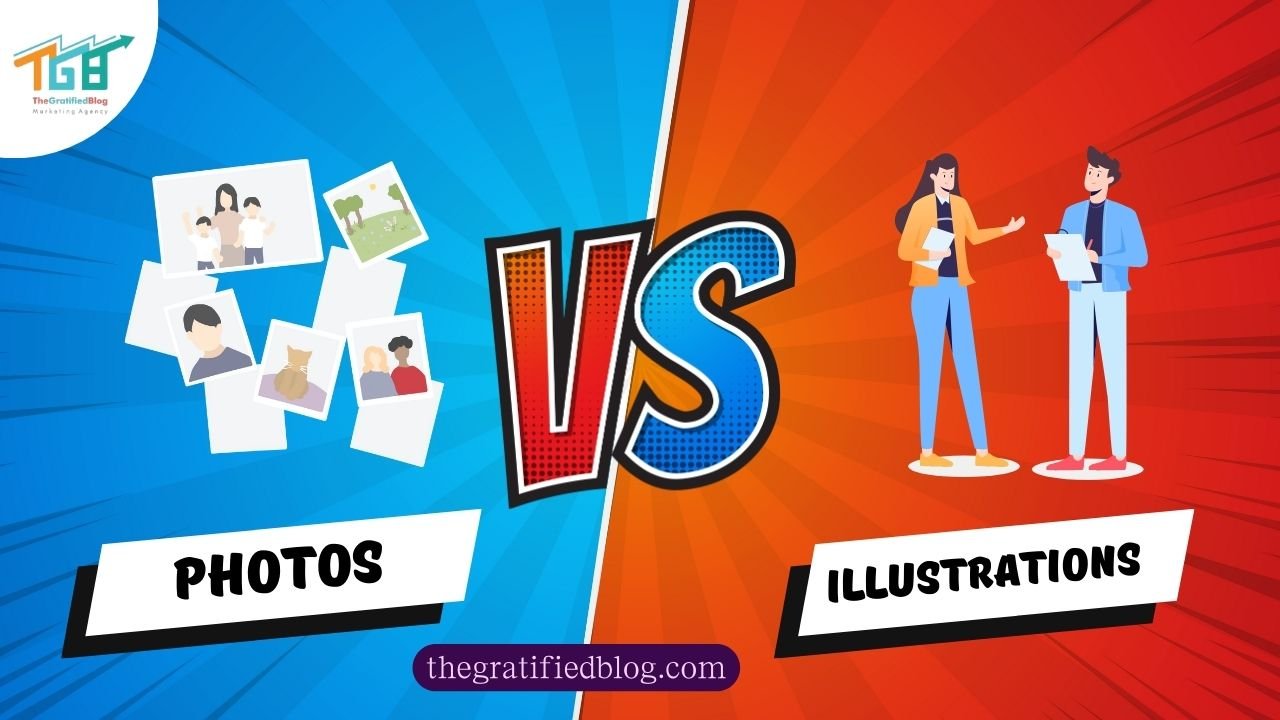
Choosing between photos and illustrations for your website is like deciding between sneakers or formal shoes. It all depends on where you’re going and what you plan to do.
When it comes to your website, you need to think harder about that choice because 38% of your visitors will likely abandon your website if they find its content and layout unattractive.
So, choosing between photos and illustrations isn’t just a matter of taste – it’s about giving your audience what they want to see.
In this guide, we’ll dive into the why, when, and how of using photos vs. illustrations to ensure your website effectively captures your audience’s interest. We’ll also sprinkle in 6 fantastic examples to spark your imagination.
Use Photos:

When You Are Showcasing Your Products
When it comes to ecommerce, there’s no room for guesswork. Your customers want to see exactly what they’re getting, no surprises.
Why Do It?
Photos offer a crystal-clear view of what you’re selling, allowing customers to inspect your products’ fine details, colors, and textures.
This visual clarity helps build trust and confidence in your brand, making it easier for customers to complete a purchase.
When To Do It?
Whenever your goal is to provide an accurate representation of your products.
This is essential for items where details matter, like fashion, electronics, machinery, etc.
How To Do It?
● Ensure your photos are high-resolution and professionally lit. Poor-quality images can be more damaging than no images at all.
● Use a consistent background (ideally white or neutral) to make your products pop and to create a cohesive look across your website.
● Offer multiple views of each product. This helps customers get a complete picture of what they’re considering.
Take a leaf out of Moto Machines’ playbook. This motorcycle accessories brand knows its audience values precision and detail.
On their Hepco & Becker product category page, they display products with clear, background-free photos. This intelligent move ensures the products pop and speak for themselves.
The result is a visually appealing page that makes it easy for bikers to find exactly what they need, reinforcing trust and encouraging purchases.
When You Are Doing Product Comparisons
Photos can be your ace when you’re laying your cards on the table, comparing your product directly with the competition.
It’s all about providing clear, visual evidence that your product is superior.
Why Do It?
Photos cut through the noise of claims and specs, offering a straightforward visual comparison that speaks louder than words.
They help customers quickly grasp the differences and benefits, making decision-making more accessible and boosting confidence in your product.
When To Do It?
Pull out the photo comparison card when you’re confident your product outshines the competition in features, design, or quality.
It’s perfect for markets where the differences might not be immediately apparent.
How To Do It?
● Use photos to spotlight your product’s unique features and benefits versus the competition.
● Sometimes, a picture needs words. Use captions or annotations to explain why your product is better.
● Ensure both products are photographed under similar conditions to maintain fairness and credibility.
SomniFix, a brand dedicated to improving sleep quality through innovative mouth strips, masterfully employs this strategy.
On their SomniFix Vs. Chin Straps comparison page, they showcase their product alongside a traditional chin strap, using high-quality images to highlight the sleekness, comfort, and efficiency of their solution.
By visually demonstrating how their mouth strips offer a more elegant and effective solution for better sleep, they educate their audience and solidify their product’s superiority.
When You Are Looking To Build Credibility
Three-quarters of consumers link the credibility of your brand to your website design. For them, seeing is believing.
Photos play a pivotal role here. They prove that what you’re offering is exactly what you claim it to be.
Why Do It?
Using authentic photos helps bridge the gap between online shopping and the physical experience.
It reassures your audience that you’re not just another faceless entity on the internet but a trustworthy source for their needs.
When To Do It?
This approach is golden when your product’s authenticity or origin is a crucial selling point.
Whether it’s a niche ingredient, a piece of handcrafted furniture, or anything in between, showing it in its proper form can make all the difference.
How To Do It?
● Use photos that accurately represent your product without unnecessary filters or edits.
● Show your product in use or its natural setting to add depth to its story.
● Highlight aspects that underscore your product’s authenticity, like packaging or unique features.
Vivion, an ingredients supplier, exemplifies this brilliantly. On their Xylitol product page, they showcase the product in its original packaging.
They understand their clientele – businesses who appreciate transparency and authenticity, and show them the product as is, without any bells and whistles,
It’s a simple yet effective strategy that resonates with their audience, proving that honesty is the best policy sometimes.
Use Illustrations:
When Your Product Cannot Be Photographed
Sometimes, what you’re selling isn’t something you can snap a photo of. Think about software, apps, or any kind of service-based offers.
Here’s where illustrations rescue, transforming the intangible into something visually graspable.
Why Do It?
Illustrations can break down complex services into understandable, relatable images.
They can convey functionality, benefits, and emotions, making your service more accessible to potential customers.
When To Do It?
This strategy shines for SaaS platforms, digital tools, or any service that doesn’t have a physical form.
It’s about giving shape to your service, making it easier for people to understand what you do and how it can help them.
How To Do It?
● Use clear, straightforward illustrations that communicate your service’s key features and benefits.
● Ensure your illustrations have a uniform style and color scheme that coordinates with your brand identity.
● Choose visuals that evoke positive emotions or showcase solutions to your audience’s problems.
Trello nails this approach. On their tour page, they employ eye-catching illustrations to showcase their team and project management platform.
These visuals neatly break down Trello’s features and functionalities, making it easy for visitors to grasp how Trello can streamline their workflows.
When It Is Part Of Your Branding
Branding is all about telling your story and setting the vibe for your audience.
When illustrations become a core part of your branding, they can convey your brand’s personality and values uniquely and memorably.
Why Do It?
Illustrations can capture and express your brand’s essence in ways photos might not.
They offer flexibility and creativity to showcase abstract concepts, values, or emotions associated with your brand.
When To Do It?
This strategy shines for brands with distinct personalities or those looking to stand out in a crowded market.
Use illustrations to consistently communicate your brand’s unique voice across all customer touchpoints.
How To Do It?
● Ensure your illustrations carry a unified style that aligns with your branding.
● Use consistent illustrations to weave your brand’s narrative throughout your site.
● Leverage the power of visuals to evoke your audience’s desired emotions and reactions.
Lemonade, an insurance company, has mastered this approach. Their site features cartoonish, black-and-white illustrations that perfectly echo their mission of providing peace of mind.
For instance, their car insurance page showcases a serene drive illustration, symbolizing the tranquility and safety they aim to provide their customers.
It’s a brilliant example of how illustrations can be a key player in a brand’s storytelling toolkit.
When You Want To Simplify Complex Concepts
Are you dealing with intricate ideas or dense data? Illustrations can be your best friend.
They can uniquely transform complex concepts into clear, engaging, and easily understandable visuals.
Why Do It?
Illustrations and infographics can distill complicated information into more approachable and memorable pieces.
This visual translation aids comprehension and retention, making your content more reachable to a broader audience.
When To Do It?
This is particularly effective for brands in sectors like research, finance, technology, or any field where the information can be overwhelming or esoteric.
That’s your cue when you want to educate or inform without losing your audience to confusion.
How To Do It?
● Prioritize simplicity and clarity over decorative elements.
● Convert your data into visual formats that highlight key insights.
● Make your visuals interactive or animated to enhance understanding further.
MoverDB shines in this arena, providing guides on international shipping and moving. In their post about low- and high-cost housing worldwide, they tackle a data-heavy topic head-on with intuitive infographics.
These visuals break down complex data into bite-sized, digestible chunks, making the confusing global housing market accessible to anyone.
This is a textbook approach to how to make your brand a go-to resource for your target audience.
Wrapping Up: Photos Vs. Illustrations
Choosing between photos and illustrations is more than a web design decision. It’s an effort that allows you to tell your unique story and attach with your audience.
So, pick the right visuals and turn your website into an unforgettable online experience.








No Comments